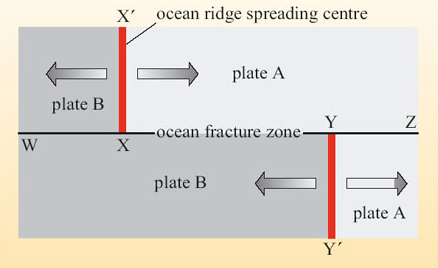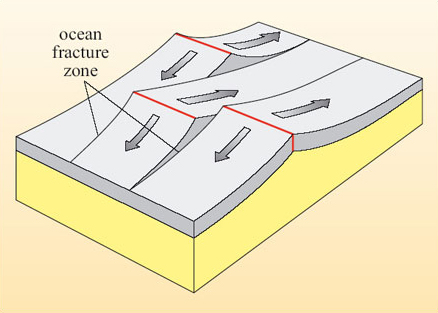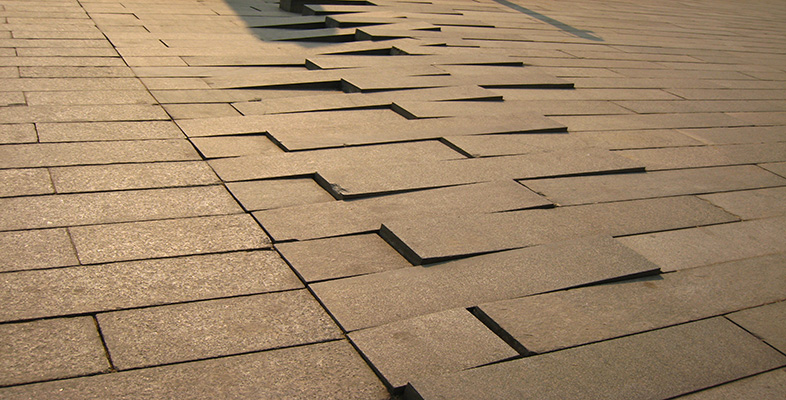3.8 Conservative plate boundaries and transform faults
Conservative plate boundaries and transform faults occur when plates slide past each other in opposite directions, but without creating or destroying lithosphere. Transform faults connect the end of one plate boundary to the end of another plate boundary, so there are potentially three types of transform fault:
-
those that link two segments of a constructive boundary
-
those that link two destructive boundaries
-
those that link a destructive boundary with a constructive boundary.
Transform faults linking two constructive boundaries are the most common, and account for the displacements between adjacent segments of mid-ocean ridges. Accordingly, this type of ocean transform fault forms an integral part of constructive plate boundaries, and their position is made obvious by the jagged shape of parts of the ocean-ridge system that are split into several segments by series of so-called fracture zones. Examples can be easily seen on the Cocos-Nazca Ridge (also known as the Galapagos Spreading Centre), and the Pacific Ocean spreading ridge (i.e. East Pacific Rise) between 10°N and 10°S, and 40°S and 55°S respectively, or manifest as shorter segments along the Atlantic Ocean spreading ridge between 0°and 40°S. Generally, oceanic transform faults occur at right angles to spreading ridges and, therefore, their orientation is indicative of the direction of plate motion.
Transform faults are seismically active - but only where two different plates are adjacent to one another. In Figure 19, the fault trace marks the boundary between plates A and B. Plate A is moving towards the east while plate B is moving towards the west.

Question 16
Describe the sense of relative movement along the length of the fault between W and X, X and Y, and Y and Z.
Answer
Between W and X, the fault separates different parts of plate B and so there is no differential movement. Between X and Y it separates plate A from plate B, which are moving in opposite directions. Between Y and Z it separates different parts of plate A and there is, again, no differential movement.
Question 17
Which part of the fault between W and Z will be seismically active?
Answer
Only that segment between X and Y where two different plates are adjacent to one another.
Only those sections of transform faults between two segments of constructive boundaries (e.g. the segment between X and Y in Figure 19) are seismically active and therefore real plate boundaries. Transform faults continue to exhibit a topographic expression beyond the constructive plate boundaries, even though only a short length of a transform fault is active. This topographic expression is simply a result of the different ages of adjacent oceanic lithosphere: younger lithosphere rests at a higher elevation than older lithosphere - this situation is illustrated schematically in Figure 20.

Transform faults associated with subduction zones are much less common, and destructive plate boundaries do not, in general, show the segmented structure so common in constructive boundaries. An example occurs at the eastern end of the Cocos-Nazca Ridge, where a heavily faulted seismic zone delineates a transform fault (the Panama Fracture Zone), connecting a constructive boundary (the eastern end of the Costa Rica Rift, which is the easternmost part of the Cocos-Nazca Ridge) with the eastern end of a destructive boundary (the Middle America Trench). Similarly, the Scotia arc in the southern Atlantic is terminated in the north by a long transform fault along the North Scotia Ridge that marks the boundary between the South American Plate and the Scotia Plate.
Occasionally, conservative plate boundaries occur in continental plates. The most famous example is the San Andreas Fault of California, which marks a segment of the boundary between the North American and Pacific Plates. Here, Baja and southern California (including Los Angeles) are moving slowly northwards relative to the rest of California. This type of transform boundary produces shallow earthquakes and accompanying ground faulting. The friction between the two plates is often so great that the two sliding margins become 'stuck' together, allowing stresses to build up, which are then relieved by large earthquakes.
